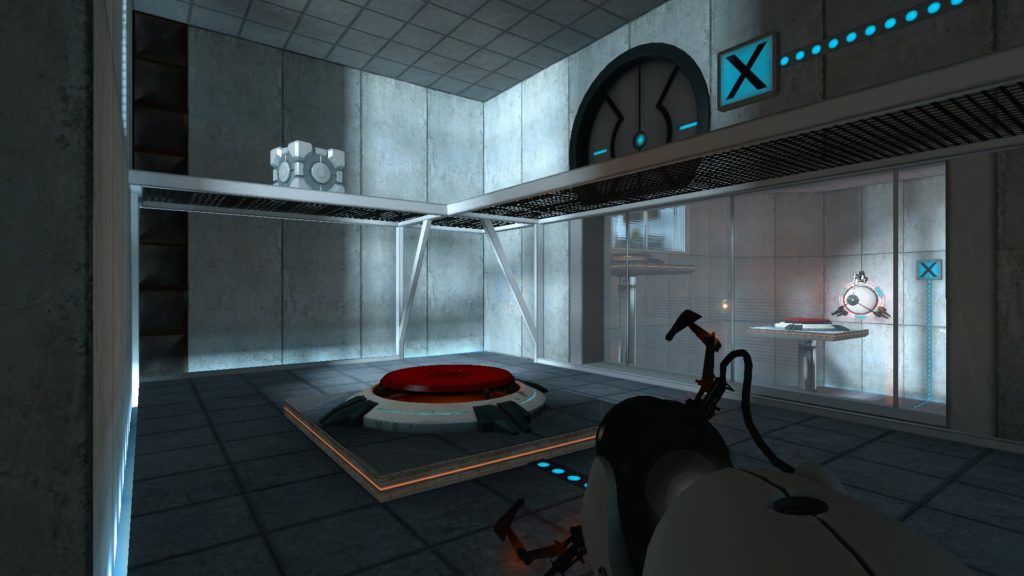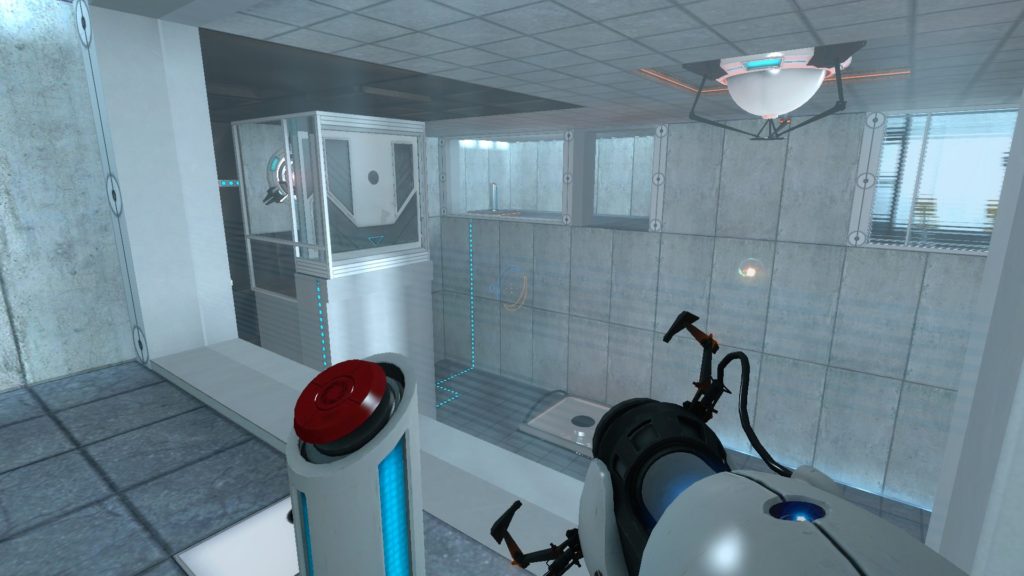This post continues a series on the way Portal introduces and interweaves its mechanics to subtly teach players with naturally escalating puzzles which constantly test their understanding. If you missed any of the previous parts, read them here, here, and here before continuing.
In the last post, we covered through Test Chamber 11, which carried with it one very important change: the player gained the upgraded Portal Gun, granting them complete control over their movement. At this point, the player has everything they’re going to have for the rest of the game; any other change is external, based on the obstacles each chamber presents. This in turn allows the chambers to become more complex and offer less immediate guidance, as they no longer need to provide one half of the solution from the start.

In the spirit of learning, however, the first chamber after acquiring control over the second portal is relatively straightforward. Chamber 12 mirrors and extends the setup of Chamber 10 before, providing a similar proportion of portalable and non-portalable surfaces along with various forms of pits and slopes to launch from. This offers a relatively familiar environment to practice using both portals without getting overwhelmed or terribly confused. As an added bonus, momentum is a very tangible mechanic to experiment with; it’s very clear to the player that their actions are doing something, and from that they can connect the dots to solve the puzzle.
Chamber 13 is the first to start challenging the player’s understanding of space when they control both portals. Up to this point, it has been a pretty constant fact that boxes must remain on buttons in order for doors to be accessible, and placing a portal on the far side of a door doesn’t work because it restricts access to the other portal. In this case, however, there’s nothing stopping the player from doing just that, and both possible solutions to the chamber require them to. The narration even acknowledges that this is a break from established conventions: “Now that you are in control of both portals, this next test could take a very, very long time.”

This has the overall effect of actually redefining the doors themselves. While they have appeared in the middle of earlier chambers, such as Chamber 05, none of them were actually part of the puzzle before. The player has the free choice to either use a portal to get past the first door with the box or only use a single box in the second room and use a portal past the final door, whichever crosses their mind first—any possible option gives them an example of how things have changed with their newfound power.
Chamber 13 starts challenging the player’s perception and Chamber 14 maintains it. Even just obtaining the box right at the start requires the player to drop through a portal and fling themselves without any particular indication to do so. This chamber also marks the first time an energy pellet receptacle is separated from an associated emitter, and in taking the box across the room to hold down a button, they may notice that the receptacle powers the exit lift—clearly an important object to remember, not that any such object has ever been in a room and not involved with the puzzle somehow.

Before continuing with the chamber, let’s discuss Portal’s conservation of detail in context to our multi-track metaphor. At no point in a composition does the composer want sound present just for the sake of sound. Every instrument serves a purpose with every note, and while some may fade into a background or supporting role for a time, their presence leads to a richer, more cohesive whole. Portal does the same thing with its mechanics: there is never an object on the beaten path which has been associated with a puzzle at any point prior and serves absolutely no purpose in the current chamber. Decorative objects do exist, such as the clipboard and coffee cup in the relaxation vault at the beginning or the security cameras placed throughout the test chambers, but they are distinct from the likes of an energy pellet or a moving platform. This creates a very clear dichotomy: either an object is very obviously required for a puzzle or it is very obviously not required. Mechanics weave in and out of relevance, but they’re never present for the sake of being present; if an energy pellet receptacle exists, there is an emitter with a pellet to deliver, and there is a path to indicate what will react when the pellet is finally delivered.
As such, we know that there is an energy pellet somewhere in Chamber 14, and the button opens the door to the only other place it could be. After a short, non-portalable hallway, the player is greeted by two platforms rising and lowering into a pit of acid. With both portals, this is hardly an obstacle—that is, until they reach the room on the far side containing the aforementioned energy pellet.

Suddenly, one portal has to remain in the pellet’s path, leaving the player to make those couple of risky jumps back; taking a portal back is an option, but hardly a safer one sharing the road with a deadly energy pellet. The setup solves the problem of basic mechanics negating simple challenges by restricting those mechanics, even if only for a short time.
This brings us to the final chamber for today, number 15. It returns once again to build on the theme of flinging oneself through portals, and continues to take away guiding indicators with each step. In the first room, while there is the now-familiar guide of a protruding wall panel above, the only marker for the second portal is a light checkerboard pattern on one part of the floor.

This section is directly in the player’s line of sight should they look at the icons on the ground, so it isn’t obtuse by any stretch, but it isn’t as cut-and-dried as previous cases. Launching over the glass wall leads to a brief, momentum-free interlude where the player is forced to notice that energy pellets are entirely unaffected by emancipation grills. In this case, the grill does little more than add a step, but it keeps with the chamber’s initial theme of using emancipation grills as obstacles in new and interesting ways.
The next room introduces a substantial new dimension to flinging. The section of the floor closest to the wall is non-portalable, which leads the player to gain initial velocity by jumping into a pit in a side room. The second step is the more complex of the two: the momentum from the small pit isn’t enough to make it over the wall, which means they need another portal to fall through. Because they just fell through one in a different room, they must place this new portal while they’re falling. It’s a more precise maneuver than the game has required up to this point, but it’s completely isolated with no risk of failure; the player is free to try as much as they need until they figure it out.

The next segment is similar, though not quite as involved. It combines aspects from earlier in the chamber; the player must fling themselves to the other side of the room in order to send an energy pellet back across to its receptacle. This activates a series of platforms in a nearby hallway, which move towards the player rather than carrying them to their next objective. In another platformer, this would be a problem, but the Portal Gun allows the player to use each platform as a vantage point to reach the next one.
The corridor leads to the final room in the chamber—a clear testament that the chambers are getting longer and more involved—and a break from its primary focus.

This room has an energy pellet at the center with its receptacle locked behind two doors. Each door is controlled by a pedestal button in one of the room’s upper alcoves, and only stays open for a few seconds after the button is pressed. While the room lacks the flinging of the rest of the chamber, it keeps the demand of quick action; to complete the puzzle the player must press both buttons in rapid succession, then place new portals to direct the energy pellet into its receptacle before the doors close. Once again, the escalation of expectations occurs in isolation, so the player has ample time to try and try again without any threat but the energy pellet in the center of the room.
That concludes our exploration for this post. We’re seeing the Test Chambers growing rapidly more complex and lengthy now that the Portal Gun’s full potential is available. Regardless, they haven’t stopped teaching the player, and the most complex new concepts are introduced in complete isolation so they can learn without fear of failure. This is important; if a student had to restart an entire assignment covering new material after missing a single question, they would give up almost immediately. Portal keeps player engagement by balancing challenge with rest, even late in the game. When we continue our journey next time, we’ll see that this remains prevalent as stakes raise higher and we draw nearer to the end. For now, I’ll leave you with the updated chart:
Join us back here in a few weeks to watch this complex symphony draw to a crescendo.


